Taking a Closer Look at Parenteral Contaminants
Visual inspection of parenteral vials is the first step in a root cause investigation.
Sezeryadigar/E+/getty images
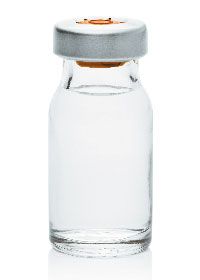
Visual inspection of pharmaceutical containers is an important step to ensure quality control and patient safety. Observations of particulate matter in containers, either by visual inspection or by automated methods, often trigger corrective actions and preventative actions (CAPAs) or other investigations. Identification of the particulate matter is then required as part of root-cause investigations and safety evaluations.
The first inspection step is to visually examine the sample with the naked eye, usually against white or dark backgrounds with a strong light source, such as a fiber-optic light. The next step should be a microscopic examination of the container. The stereomicroscope is a valuable tool to better characterize the particulate and determine the best method for isolation and analysis.
There are a variety of pharmaceutical product packaging options, and the choice of packaging is dependent on many factors including the nature of the product and its end use. The focus of this paper is on parenteral glass vials and syringes. This paper discusses three sources of particulate issues that can be successfully evaluated using stereomicroscopic examination: container-related contamination (glass delamination), product-related particles (protein aggregates), and environmental contamination.
The stereomicroscope
Figure 1: Olympus SXZ10 stereomicroscope equipped with transmitted, oblique, and coaxial (reflected) light sources.
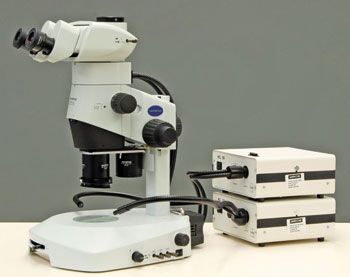
Stereomicroscopes, such as the one pictured in Figure 1 are low to moderate magnification, binocular microscopes that allow a stereo or 3-D view of the sample. The stereomicroscope’s large working distance--the space between the stage and objective--allows space for the examination of small containers in situ. Stereomicroscopes can also be fitted with a connector that supports a digital camera. The lighting conditions are important, and several options can be used individually or together to better evaluate a sample. Transmitted light is the most commonly used illumination source and is usually the first lighting method used for examination of the vial or other sample. Stereomicroscopes often have a knob that tilts the transmitted light and is analogous to dark-field microscopy. This indirect transmitted lighting is useful to see particulates that are not readily visible using ordinary transmitted light. Oblique or side lighting is also important to determine the color of the particles in solution.
Glass delamination of parenteral vials
Glass delamination is a major concern in the parenteral pharmaceutical industry. Glass delamination is defined in United States Pharmacopeia (USP) <1660> as the appearance of very thin glass flakes, or lamellae, that are generated by deterioration of the inner glass vial wall (1). There are several factors that contribute to delamination including vial manufacturing, vial processing, and the chemistry of the product liquid itself. These factors are not fully understood, but the appearance of flakes in solution indicates that the delamination process is advanced. To avoid this problem in new product submissions, it is recommended to test product-filled containers from multiple vial suppliers with accelerated stability (high temperature and humidity) conditions. The vials are examined at time intervals to determine if flakes are present. Inspection of the vials is a crucial component of the suitability study process.
The suspect vial is examined visually against a black background with a fiber optic light source positioned next to the vial. The vial is gently swirled, and glass delamination flakes, if present, cause a twinkling or sparkle that is observable even if the particles are not readily visible. The next step is to examine the vial using the stereomicroscope with the indirect lighting described in the earlier section. The glass delamination flakes are extremely thin (1 µm or less) and appear as flakes or needles in solution that “disappear” when the vial is rolled. The flakes are no longer observable as they are too thin in the z dimension to be observed using light microscopy.
If the flakes are observed in solution, the product liquid can be filtered onto filter membranes for further examination and analysis. Due to their extreme thinness, the glass delamination flakes are only observed on the filter using coaxial light. A light micrograph of glass delamination flakes as they appear on the filter is shown in Figure 2.
Figure 2: Glass delamination flakes as they appeared on a polycarbonate filter membrane. The photograph was taken using a higher magnification polarizing light microscope with reflected light.
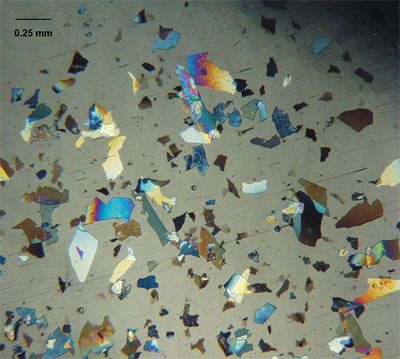
Stopper coring particles
Many parenteral vials have gray butyl rubber stoppers that are pierced with a syringe needle to administer the drug. The syringe needle sometimes creates a coring particle that appears with the naked eye to be a black or dark particle in the vial solution. If this particle is observed visually by the practitioner administering the drug, the sample is returned as a client complaint. When the vial is viewed with the stereomicroscope, the dark particle is often observed more accurately as gray polymeric material.
Product-related particulate
Some particulate problems are related to the product formulation itself. These types of particulate are often related to the API, but may also sometimes include other formulation components. API-related particulate may form due to a change in crystal structure (polymorphism), pH, or some other type of reaction or degradation. In some cases, the particles may be crystalline, but most often, they appear as amorphous residue.
Figure 3: Stringy and flake-like aggregated protein as it appeared in product solution. The photograph was taken through the vial wall with a stereomicroscope and indirect transmitted light.

Biologically derived pharmaceutical compounds are protein-based material and in some conditions, the protein aggregates and forms an insoluble particulate. Protein aggregation often appears in solution as stringy, fiber-like particles, but also can appear as globular particles, sheet or web-like material, or very small fine particles. A photomicrograph of a stringy protein aggregate that was taken through the vial wall using indirect transmitted light is presented in Figure 3. This type of particulate is soft and deforms readily. When the particulate is isolated by filtration, the material flattens and collapses onto the filter and often does not have the same morphology on the filter as it did in solution. This type of particulate is very thin and, like glass delamination flakes, is only observed on the filter using coaxial light. A photomicrograph of typical protein aggregate particulate as it appears on the filter is shown in Figure 4.
Figure 4: Aggregated protein residue captured on a polycarbonate filter membrane. The photomicrograph was taken with a stereomicroscope using coaxial (reflected) light.
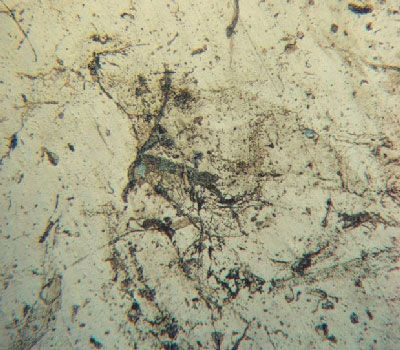
If silicone is present in the vial, the silicone may be associated with the aggregated protein. The vial stoppers are often the source of the silicone, and measures such as fluoropolymer-coated stoppers are often used to eliminate excess silicone. Single-use syringe barrel interiors are coated with silicone to allow plunger movement. Silicone appears in aqueous solution as fine spherical “bubbles” that differ greatly in appearance from air bubbles.
Environmental contamination
Pharmaceutical manufacturing industries have procedures and safeguards in place to ensure quality and cleanliness such as aseptic filtration. However, sometimes environmental or manufacturing debris may be observed in containers. The most common environmental contaminant is fibers. True fibers, such as cotton or paper fibers, are heavier than stringy protein aggregates described previously, and they sink in solution after gentle swirling.
Further microscopical or chemical analysis is needed to positively identify a fiber, but it can often be classified based on the stereoscopic examination. Cardboard or kraft paper fiber fragments are light yellow in color and are often present as matted fibers. Synthetic fibers such as polyester or polyolefin that may be generated in cleanroom environments have smooth surfaces; usually a distinction may be made of natural versus synthetic based on the visual examination. In some rare instances, a hair may be observed in a sample. Hairs have distinct morphology that can be used to classify the particle.
Polymeric shavings are a less frequently encountered contaminant, but when present are often described as “fibers” after a visual examination. Polymeric shavings are usually readily distinguished from true fibers (see Figure 5) using the stereomicroscope. Soft polymers such as Teflon or polyethylene may have metal wear particles or corrosion deeply embedded in the surface and may appear visually as dark fibers. Precise identification of polymeric particles requires chemical characterization using infrared spectroscopy.
Figure 5: A cellulosic fiber as it appeared in product solution. The photograph was taken through the vial wall with a stereomicroscope and indirect transmitted light.
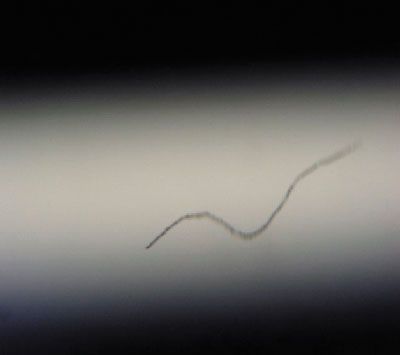
Dark specks are sometimes reported in vials. The stereomicroscopic evaluation is useful to further classify this type of particle. Dark particles often are due to fibers or polymeric particles that remained in the vial after cleaning and were badly charred during the depyrogenation process. The vial is then filled, and the dark particle is sloughed off of the surface and appears in solution. Fibers often retain their shape or morphology but turn brown or black and become fragile.
Examination of the particle in situ is important as the particle may break up during isolation. Polymeric particles turn a characteristic translucent amber-brown when oxidized.
Dark particles may also be metal and/or corrosion. Corroded particles may be orange, brown, or black in color and may not appear to be metallic. To determine if a black speck is steel and/or corrosion, a magnet can be run along the side of the vial while viewing through the stereomicroscope. If the particle is magnetic, it will move toward the magnet.
Sometimes the particle is actually a flaw or particle encased within the vial wall. This type of vial manufacturing defect may be perceived as a particle. This type of particle does not move when it comes into contact with solution when viewed with the naked eye. The location of the particle can be determined by stereomicroscopy.
Samples may have more than one type of particle present, which suggests multiple sources. The stereomicroscope is useful to fully evaluate the scope of the sample prior to initiating any isolation or analysis. In the example shown in Figure 6, gray particles and white wispy particles were observed in a vial. The differences in color were highlighted by the use of oblique light. The gray polymeric particles were stopper coring particles and the white wispy particles were aggregated protein.
Figure 6: Gray polymeric stopper coring particles and whitish aggregated protein as they appeared in a glass vial. The photomicrograph was taken with a stereomicroscope using oblique light.

Summary
Inspection of parenteral containers is an important tool to ensure cleanliness and safety of the product. Stereomicroscopic examination provides more information and detail than visual inspection with the naked eye. This information can be used to select the most appropriate isolation and analysis methods, which in turn leads to a successful root cause analysis and safety evaluation.
Reference
1. USP39-NF 34 General Chapter <1660>, “Evaluation of the Inner Surface Durability of Glass Containers.”
All Figures are courtesy of the author.
Article Details
Pharmaceutical Technology
Vol. 40, No. 9
Pages: 34–38
Citation:
When referring to this article, please cite as G. L. Shearer, “Taking a Closer Look at Parenteral Contaminants," Pharmaceutical Technology 40 (9) 2016.

Pharmaceutical Tariffs Are Imminent: How Industry is Bracing for Impact
April 16th 2025On April 14, 2025, the Trump Administration launched a national security-driven investigation into pharmaceuticals, a move that will likely result in tariffs being placed on pharmaceutical drugs, ingredients, and other components that are imported from outside of the United States.